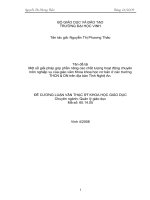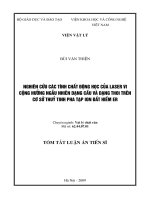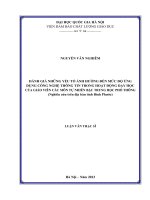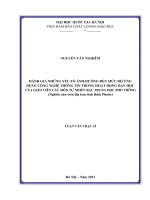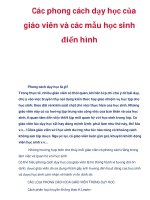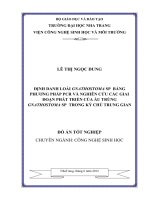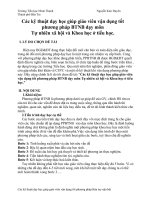nghiên cứu các thủ thuật dạy học của giáo viên nhằm nâng cao kỹ năng đọc cho sinh viên năm thứ nhất tại trường cao đẳng kinh tế công nghiệp hà nội
Bạn đang xem bản rút gọn của tài liệu. Xem và tải ngay bản đầy đủ của tài liệu tại đây (594.14 KB, 59 trang )
VIETNAM NATIONAL UNIVERSITY, HANOI
UNIVERSITY OF FOREIGN LANGUAGES AND INTERNATIONAL STUDIES
FACULTY OF POST – GRADUATE STUDIES
ĐẶNG THÚY HẰNG
A STUDY ON THE TEACHERS’ TEACHING TECHNIQUES FOR IMPROVING
THE READING SKILLS OF FRESHMEN AT HANOI COLLEGE OF
INDUSTRIAL ECONOMICS
(Nghiên cứu các thủ thuật dạy học của giáo viên nhằm nâng cao kỹ năng đọc cho sinh viên
năm thứ nhất tại trường Cao đẳng Kinh tế Công nghiệp Hà Nội)
M.A MINOR PROGRAMME THESIS
Field: English Teaching Methodology
Code: 60 14 01 11
HANOI, 2014
VIETNAM NATIONAL UNIVERSITY, HANOI
UNIVERSITY OF FOREIGN LANGUAGES AND INTERNATIONAL STUDIES
FACULTY OF POST-GRADUATE STUDIES
ĐẶNG THÚY HẰNG
A STUDY ON THE TEACHERS’ TEACHING TECHNIQUES FOR IMPROVING
THE READING SKILLS OF FRESHMEN AT HANOI COLLEGE OF
INDUSTRIAL ECONOMICS
(Nghiên cứu các thủ thuật dạy học của giáo viên nhằm nâng cao kỹ năng đọc cho sinh viên
năm thứ nhất tại trường Cao đẳng Kinh tế Công nghiệp Hà Nội)
M.A MINOR PROGRAMME THESIS
Field: English Teaching Methodology
Code: 60 14 01 11
Supervisor: Dr. Trần Thị Thu Hiền
HANOI, 2014
i
DECLARATION
I, Dang Thuy Hang, hereby certify that this minor thesis entitled “A study on
the teachers’ teaching techniques for improving the reading skills of freshmen at
Hanoi College of Industrial Economics” is the result of my own research in the
fulfillment of the requirement for the Degree of Master of Arts at Faculty of Post
Graduate Studies - University of Languages and International Studies – Vietnam
National University, Hanoi.
Hanoi, April 2014
Signature
Đặng Thúy Hằng
ii
ACKNOWLEDGEMENTS
On the completion of this thesis, I would like to give my sincere thanks to many
people for their encouragement and assistance during the preparation of my thesis.
First and foremost, I would like to express my deepest gratitude to my supervisor, Dr.
Tran Thi Thu Hien, who has been most willing and ready to give me valuable and
helpful guidance, advice and support during the most difficult time of thesis
construction. Without her help, this thesis would not have been made possible.
I would also like to express my thanks to the lecturers and the staff of the Departure of
Postgraduate Study at College of Foreign language for their useful lectures and careful
guidance.
My special thanks also go to English teachers in Foundation faculty, at Hanoi
College of Industrial Economics for their enthusiastic participation and constructive
suggestions for the development of the study. And I also wish to express my thanks for
the great cooperation from the freshmen in the classes: CKX12.3, CKX12.8, CKT12.6,
and CKT12.10 in the data collection of my study.
Last but not least, my sincere thanks go to my family who give me much
motivation, energy and support in accomplishing this challenging work.
iii
ABSTRACT
This study investigates the real situation of teaching and learning reading skills
at HCIE for freshmen and providing some suggested reading teaching techniques for
the teachers to help teachers and students teach and learn reading skills more
effectively. To attain these objectives, three kinds of instruments are applied such as
survey questionnaire, observation and semi- interview. Ten English teachers and one
hundred students are selected to be participants of the survey. Necessary data are
gathered using questionnaires for both students and teachers. Contributing to these
data, observation is used to get useful information at CKX12.8 where is experimented
some effective teacher’s teaching techniques. In addition, five teachers are randomly
chosen to give their opinions about their real teaching experience, difficulty and
solutions. From the findings, the study depicts that while students are passive and
demotivated in learning, the teachers’ techniques are dominated by traditional
approach which are not effective enough to improve students’ reading skills. Basing
on the research’s results, some recommendations for the students, the teachers and the
authorities are stated. In conclusion, this study’s findings contributes a better
understanding of teaching and learning reading techniques in general and teachers’
reading techniques in particular; however, some debatable points are unavoidable in
this thesis.
iv
TABLE OF CONTENTS
Declaration………………………………………………………………………… i
Acknowledgements………………………………………………………………….ii
Abstract…………………………………………………………………………… iii
List of abbreviations………………………………………………… …viii
List of tables and figures …………………………….………….………………….ix
PART A: INTRODUCTION…………………………………………………… 1
1. Rationale of the study……………………………………………………………1
2. Aims of the study…………………………………………………………….… 2
3. Research questions………………………………………………………….… 2
4. Scope of the study………………………………………………………….…….2
5. Methodology…………………………….………….……………………….… 2
6. Significance of the study…………………………………………………….… 3
7. Structure of the study……………………………………………………….… 3
PART B: DEVELOPMENT………………………………………………….… 5
Chapter 1: LITERATURE REVIEW……………………………………….……5
1. 1. An overview of the nature of reading skills…………………………….… 5
1.1.1. Definition of reading……………………………………………….……… 5
1.1.2. Reading comprehension…………………………………………………… 6
1.1.3. The importance of reading in foreign language teaching and learning… 6
1.2. Teaching reading skills……………………………………………………… 7
1.2. 1. The objectives and goals of teaching reading………………………… ….7
1.2.2. The reading teaching/ learning approaches…………………… …… … 10
1.2.3. Techniques for teaching reading……………………………… …………12
1.3. Factors affecting teaching and learning reading………………… ……… 14
1.3.1. The reading text……………………………………………….……………14
1.3.2. The student………………………………………………………….………15
1.3.3. The teacher……………………………… ………………… ……………16
1.5. Summary……………………………………………………… …………….17
Chapter 2: THE STUDY…………………………………………………………18
2. 1. The context……………………………………….………………………….18
2.1.1. An overview of Hanoi College of Industrial Economics…………… ……18
v
2.1.2. Teachers and teaching methods………………………….…………… ….19
2.1.3. Students and their background English knowledge………………… ….20
2.1.4. Teaching materials ……………………………….…… …… ……… ….20
2.2. The study…………………………………….………… ………… 21
2.2.1. Participants……………………………………………… …………….….21
2.2.2. The instrument……………………………………………….………….….22
2.2.3. Data collection procedure………………………… ………………………23
2.3. Data analysis…………………………………………….………….… …….23
2.3.1. The survey questionnaires…………………………….…………………….23
2.3.2. The class observation ……………………….……………………… ….…29
2.3.3. The semi-interview……………………………………….………… ….….32
2.4. Summary……………………………………………………….……… ……32
Chapter 3: RECOMMENDATIONS……………………… ………………… 34
3.1. To the students ………………………………………………… …… … 34
3.2. To the teachers………………………………………………… … … 35
3.3. To the authorities…………………….……………………………… ……36
3.4. Summary………………………………………………………… … ……37
PART C: CONCLUSION……………………… …………………… ………38
1. Conclusions………….…………………………………………… … ……38
2. Limitations and Suggestions for further studies………………… ………39
References:………………………………………………………… ………40
Appendices…………………………………………………………… …… I
vi
LIST OF ABBREVIATIONS
CLT: Communicative language teaching
EFL: English as foreign language
ESL: English as second language
ESP: English for specific purposes
HCIE: Hanoi College of Industrial Economics
NCLRC: National Capital Language Resource Center
NHWP: New headway pre-intermediate
OU: Open University
Ss: Students
Ts: Teachers
ULIS, VNUH: University of Languages and International Studies,
Vietnam National University, Hanoi
vii
LIST OF TABLES AND FINGURES
Table 1: Students’ and teachers’ attitude toward the course book (p 23)
Table 2: Students’ attitude toward the reading activities (p 24)
Table3: Students’ attitude toward the teacher’s techniques and preferring
techniques (p 25)
Table 4: Teachers’ technique of combination and its efficiency (p 26)
Table 5: Teachers’ responses concerning Pre-reading activities (p 26)
Table 6: Teachers’ responses concerning While-reading activities (p 27)
Table 7: Teachers’ responses concerning Post-reading activities (p 28)
Table 8: Students’ and teachers’ attitude toward supplementary texts (p 29)
- 1 -
PART A: INTRODUCTION
1. Rationale
On the road of integrating and developing in Vietnam, English is quite important to
learners. The teaching and learning of English is paying much more attention by
both teachers and learners.
Nowadays, a lot of universities require their students to learn English as one of their
general subjects. In order to master English, students have to try their best to develop
the English skills such as listening, speaking, writing and reading. There have been
debates on the topic: which skill in English teaching and learning is the most
important? There are some who state what they need is only speaking English fluently.
Some disagree with that idea. They consider writing is vital because documenting
reports, letters, etc are what they daily deal with in their work and life. In contrast, there
are still some who propose listening is more important for the realization of their goal.
However, among these skills, according to the writer, reading is the most important one
because it helps not only develop other skills but also provides learners knowledge of
the target language. Reading is also benefit for the students in a lot of aspects in
acquaintance of a new language. This topic interests a lot of researchers to put their
passion on. One of the famous scholars whose reputation is not able to forget Grellet
(1981) with his famous book on reading such as “Developing reading skills” In
addition, many Vietnamese authors and researchers pay much attention to this issue.
For example “A study on how to improve the teaching of reading English in Economics
to the 2
nd
year students at Hanoi national Economics University” by Trang (2005)
refers to reading skill in Economics only, and “ A study on how to improve ESP
reading skills for the students of Information Technology” mainly focuses on reading
skills for Information Technology students by Huong (2003). Hop (2008) also concerns
this topic in her MA thesis “Improving reading skills of Post Graduate Students at
College of Natural Sciences, VNU by developing the reading materials”. Although this
subject gains a lot of interest from researchers and linguistics, there have not been any
researchers who does research on the teacher’s reading techniques. This is one of the
main reasons which raises the interest for the author to do this research.
- 2 -
As an English teacher of a college in Hanoi which testing is mainly based on
grammar structures and reading texts, the researcher realizes that both teachers and
students have difficulty in finding the effective way to teach and learn reading
skills. Moreover, in order to improve learning environment and teaching quality,
there is a need of investigation to expose the new road for all subjects in general and
reading skills in particular at the college. With the effort of my own, a study is
carried out to find which reading techniques are more effective for improving the
quality of teaching and learning reading skills at HCIE.
That is the reason why my graduate paper is “A study on the teachers’ teaching
techniques for improving the reading skills of freshmen at Hanoi College of
Industrial Economics”.
2. Aims of the study
This paper aims at:
- Investigating the real situation of teaching and learning reading skills for freshmen
at HCIE.
- Providing some suggested reading teaching techniques for the teachers to help
teachers and students teach and learn reading skills more effectively.
3. Research questions
To reach the above aims, the thesis works to answer two following research questions:
- How reading skills are being taught and learnt at HCIE?
- What reading techniques should be applied to improve the reading skills of
freshmen at HCIE?
4. Scope of the study
This study focuses on improving the reading skills of freshmen at HCIE. Efforts to
study the improvement of other skills, for students of other years at other
institutions are above the scope of the study.
5. Methodology
With the purpose of investigating the teachers’ teaching techniques for improving
the reading skills of freshmen at HCIE, this study employs a survey research. To
achieve this aim, the survey questionnaire is used as the main instrument to collect
- 3 -
the needed data from the students and the teachers. Besides, other instruments are
also made used of such as the researcher’s observation in reading lessons, and the
semi-interview for English teachers.
6. Significance of the study
In the light of CLT, to find suitable techniques for teaching and learning reading
requests a lot of enforce from both teachers and students.
In relation to this, an investigation on the teachers’ teaching techniques for
improving the reading skills of freshmen at Hanoi College of Industrial Economics
is implemented. To this end, the result of this study is believed to have potential
contribution to the following two aspects:
Firstly, in theory, this thesis once more time approves the reading background. It
adds into reading skills a strong point to consolidate the teaching reading
methodology.
Secondly, in practice, the paper is beneficial for teacher trainers and educators who
have a role in teaching and training to improve reading practice. In addition, it is
able to contribute to English teachers who can use the results to reflect on
their practice to improve their reading lessons. Moreover, researchers who are
interested in classroom practice may use the findings as a stepping-stone for further
investigation that could lead to the improvement of teaching reading for second year
students in or out of HCIE.
7. Structure of the study
The study includes three main parts:
The first part is the Introduction. The writer states the rationale for choosing the
topic of the study, the aims of the study, the research questions, the scope of the
study, methodology, the significance of the study and the structure of the study.
The second part is the Development which is divided into three chapters. Chapter
one presents the back ground knowledge of reading skills. The next chapter works
on the teachers’ teaching techniques on reading skills for freshmen at Hanoi College
- 4 -
of Industrial Economic. The last chapter is about some techniques to improve
reading skills to freshmen at Hanoi College of Industrial Economics.
The last part is the Conclusion. In this part, the writer gives out the summary, the
limitation of the study and the suggestions for the further study.
- 5 -
PART B: DEVELOPMENT
Chapter 1: LITERATURE REVIEW
1. 1. An overview of the nature of reading skills
1.1.1. Definition of reading
Reading skill is one of four macro-skills in teaching and learning a language in general
and a foreign language or second language – English in particular. This term has been
attracting a lot of scholars, linguistics, educators and teachers to give the attention to.
So many definitions of Reading are given out. It is the fact that each person has his own
way to define it. Obviously, giving an exact definition for the word “reading” is not an
easy work. As Aebersold and Field (1997:5) notes that “the act of reading is not
completely understood nor easily described.” In this paper, some of typical
definitions are listed to give an overview of the term “reading”.
Firstly, Goodman (1981: 135) proposes that reading is “a psycholinguistic process
by which the reader, a language user, reconstructs, as best as he can, a message
which has been encoded by a writer as a graphic display”. Clearly, reading is an act
that involves the reader works to find out the meaning encoded by written letters.
This definition points out three elements in reading process: the writer, the reader
and the text. Another definition of reading is suggested in the interactive view of
reading. In fact, contemporary interactive approaches to reading extend and
elaborate psycholinguistic theory by focusing precisely on the important role of
cognition in an interaction between the reader and the text. Thus, McKenna and
Robinson (1993:21) defines that “reading is an interactive process in which a
reader’s prior knowledge of the subject and purpose for reading operate to
influence what is learned from text.” This opinion is as the same as Silberstein’s
(1994:7) when she emphasizes that meaning does not fully lie in the text to be
decoded. Rather meaning is created through the negotiation between a reader and a
text. This means a reader is an active participant in the reading process in which the
reader makes predictions and form expectations from the prior knowledge, which
the reader confirms or rejects while reading.
- 6 -
In short, each scholar has a different definition of reading and it is a hard job to
decide which is better because each of them focuses on one important matter of
reading. However, there still has a common thing is that reading is a complex
process that requires a great deal of active participation of readers in order to find
the message hidden in the printed words.
1.1.2. Reading comprehension
Comprehension is one of key important components of essential reading instruction.
It is a vital tool for reading in the modern age. Thus, it can be said that it plays an
important part in teaching and learning a foreign language. It is the ability to
understand information in a text and interpret the text appropriately.
Reading comprehension is defined as obtaining the information from the text.
According to Abbott (1981: 82),“There are two broad aspects or levels. Firstly,
there is basically visual task that of deciphering the marks on the page, the brain
receiving signals from the eyes. Secondly, there is cognitive task that of interpreting
the visual information, so one is not simply barking at point.” With the same idea,
Grellet (1981:3) states “reading comprehension or understanding a written text
means extracting the required information from it as effectively as possible.”
Another point of view comes from Rirchard and Thomas (1987: 143). In his opinion
reading comprehension is a mental process that only the reader finally understands the
text based on the past experience. That knowledge is, then, used in trying to get meaning
out of printed text. So, the process of comprehending involves decoding the writer’s
words and using the background knowledge to construct an approximate understanding
of the writer’s passage. Agreeing with this theory, Lenz (2000: 3) also says that “reading
comprehension is the process of constructing meaning from the text.”
A conclusion can be drawn here is that reading comprehension is the process that
helps the readers obtain information in a text and understand it appropriately.
1.1.3. The importance of reading in foreign language teaching and learning
It is generally accepted nowadays that reading is a key skill for most students
learning a foreign language and that it should therefore, take place alongside the
- 7 -
development of oral ability in the school program. Having the same idea Carrell
(1997:1) agrees: “for many students, reading is by far the most important of the four
macro skills, particularly in English as a second or a foreign language”
First of all, reading is a means by which further learning takes place. It is an
effective way of stimulating students to talk, write and listen. By reading, learners
are able to enrich their knowledge of grammar structures and vocabulary items.
These factors contribute an important part to help students easier to listen to the
lessons. In addition, knowledge of structures and new words ungraded by reading
also provides learners a chance to speak more confidently and naturally. Next,
writing skill is improved based on the model reading texts.
Secondly, reading weighs as a heavy tool belt of a working, technological society. It
helps us to solve both personal and social problems in daily life. Print is
everywhere: memos and menus, candy wrappers and constitutions, bills and serial
numbers, signs and rest room doors. Without reading anything, it is impossible for
human beings to behave appropriately.
Finally, reading in a new language is also to be beneficial to learn about the target
culture. It helps learners understand the ways of life, behavior, thought, belief, etc.
that pays an important role in widening the knowledge of cross-culture.
To sum up, reading is a vital skill in learning and teaching a second language.
1.2. Teaching reading skills
1.2. 1. The objectives and goals of teaching reading
1.2.1.1. The objectives of teaching reading skills
Clearly, everything is done including at least an objective. It is the same with
reading or teaching reading skills.
According to Christina and Mary (1976: 169): “The objectives of teaching reading are
self-evident; we read for information and for pleasure.” Totally agreeing with this idea,
Grellet (1981:4) claims that reading consists of two main reasons. They are reading for
pleasure and reading for information. Having the same opinion, Heidi (1998) says that:
“Reading is an activity with a purpose. A person may read in order to gain information
or verify existing knowledge, or in order to critique a writer's ideas or writing style. A
person may also read for enjoyment, or to enhance knowledge of texts.”
- 8 -
According to a study carried out by Greany and Neuman (1990), to find out the
children’s reasons for reading through questionnaires administered in 15 countries to
thousands of 10- and 13-year-old students. The results got divided into three main
factors that they termed “utility”, “enjoyment” and “escape”. Whereas, utility was
reading to learn to become successful in school or life, enjoyment meant reading for
pleasure and interest, and escape indicated reading to kill time or avoid boredom.
However, each level of reading has different particular objectives. For example,
Christina and Mary(1976: 169) also points that the purpose of reading on the very
elementary level includes two main ones. Firstly, reading is to introduce basic
grammar patterns and vocabulary items in context. Reading, secondly, is to
reinforce this basic knowledge.
In short, clarifying the particular objectives of teaching reading is an important job
that helps to guide both teachers and students to go for the right way.
1.2.1.2. The goals of teaching reading skills
According to Sadoski, M ( 2004: 44) every subject is taught and learnt is classified in
one of three domains. They include the psychomotor domain, the affective domain
and the cognitive domain. These stretch in teaching and learning reading as well.
The psychomotor domain is the domain of the mind and the body working together
to produce physical performances. Some examples of psychomotor activities
include learning to walk, tie shoelaces, swim, type, drive a car, and perform creative
dance routines. The second domain is the affective domain which is the domain of
attitudes, interests, values, appreciation, and life adjustment. The common examples
of affective activities are responding positively to success and constructively to
failure, adopting healthy habits over unhealthy ones, developing a democratic
tolerance for opposing points of view, or invoking ethical principles for behavior in
morally ambiguous situations. The third domain is the cognitive one which consists
of intellectual skill including the recall or recognition of information, the
comprehension of information, and the development of logical and rational thought
skills such as analysis, synthesis, and evaluation. The popular examples of cognitive
activities are remembering facts, summarizing thoughts, applying principles to solve
problems, deducing a coherent explanation from disparate pieces of evidence, or
objectively critiquing arguments in terms of their logical consistency.
- 9 -
In applying these domains in teaching reading skills, they were divided into small
goals which were equal between the affective domain and the cognitive domain, and
the psychomotor domain was eliminated. Each domain contains two goals. Two
goals in the affective domain are developing positive attitudes toward reading and
developing personal interest and tastes in reading. Two goals in the cognitive
domain are developing the use of reading as a tool to solve problems and
developing the fundamental competencies of reading at succeedingly higher levels
of independence. The first goal deals with developing positive attitudes toward
reading. It means that readers try to improve or make progress in their confidence in
their own ability. In other words, students should experience success regularly and
approach reading confidently without being fear of failure. The readers may
experience difficulty in reading and sometimes they may get the negative attitude.
However, bearing in their mind of the positive thinking that helps them overcome
the difficulty easier and develop their positive attitude. The next goal is developing
personal interest and tastes in reading. Having an interest in reading means having
the motivation to read and to respond affectively, to seek to enlarge self-
understanding and sense of self-worth through reading. At the higher level of the
development of interest is the development of discriminating value judgment, or
taste. It means that readers can have tendency to make value choices and judgments
about what they chose to read and to develop their own critical standards. The third
goal is developing the use of reading as a tool to solve problems. Clearly,
everything bears printing words on it, for examples, candy wrappers, constitutions,
bills and rest room doors, etc. Reading them helps readers know what is what and
what for. Reading is a way to deal with everyday problems from reading to learn at
school to reading to do at work. So, using reading as a tool in our daily lives is
pervasive. The last goal is developing the fundamental competencies of reading at
succeedingly higher levels of independence. This is the most basic goal and
provides the means to the other ends. According to Chall (1996: 18), reading is
classified into six stages with particular goals:
Stage 0, Pre-reading (0–grade 1):developing concepts about print;
recognizing print in the environment; learning some letters and words.
- 10 -
Stage 1, Initial Reading or Decoding (grades 1–2): learning letters and
letter combinations and their correspondence with parts of spoken words;
learning to crack the code.
Stage 2, Confirmation, Fluency, Ungluing from Print (grades 2–3):
learning more about decoding; using context to increase fluency and rate;
reading simple stories and beginners’ books.
Stage 3, Reading for Learning the New: A First Step (grades 4–8):
learning to read begins to shift to reading to learn; developing vocabulary
and knowledge; beginning to use subject area textbooks.
Stage 4, Multiple Viewpoints (high school): dealing with more mature texts
that introduce varying viewpoints and more challenging concepts; more
independent reading.
Stage 5, Construction and Reconstruction- A World view (college and adult):
more advanced and discriminating reading; constructing knowledge on a high
level of abstraction and generality; varying purposes and rate; critical reading.
In short, setting clear goals that makes readers at any ages become wiser and more
effective ones. In teaching reading, taken together these goals helps us to imagine
an ideal state of affairs in a reading class and provide a conceptual basis for the
why of teaching reading.
1.2.2. The reading teaching/ learning approaches
Sadoski, M ( 2004: 81-88) states the three fundamental teaching/learning approaches
on the second continuum (instruction and education) which were program-controlled
teaching/ learning, teacher-controlled teaching/learning, and reader-controlled
teaching/learning. These are the ways in which we teach readers to do it.
In program-controlled teaching/learning: the program is dominant and the
teacher and the reader are subordinate.
In teacher-controlled teaching/learning: the teacher is dominant and the
program and the readers are subordinate. In this approach, the teachers
determine the learning conditions according to their professional training,
- 11 -
experience, and judgment. Programs and text materials are used according to
those determinations, and readers are subject to those determinations.
In reader-controlled teaching/learning: the reader is dominant and the
teacher and the program are subordinate.
However, Elba(2006:8) gives out another teaching reading approaches applied a lot
currently. According to him, there are three popular models such as: bottom-up
approach, top-down approach and interactive approach.
Bottom-up approach focuses on developing the basic skill of matching
sounds with the letters, syllables, and words written on a page. It is
associated with a teaching methodology called phonics which requires the
learner to match letters with sounds in a defined sequence.
Top-down approach focuses on the background knowledge a reader uses to
comprehend a written text. It is associated with schema theory which describes in
detail how the background knowledge of the learner interacts with the reading
task and illustrates how a student’s knowledge and previous experience with the
world is crucial to deciphering a text. As a result, the reader and linguistic
knowledge plays a key role in the construction based on the text’s meaning.
The interactive approach refers to the interaction between bottom-up and top-
down processing skills. It involves the simultaneous occurrence of two processes
belonging to the above approaches. Understanding depends on both processes of
graphics information and reading memory of the reader. Understanding may be
hampered by lack of critical judgments or ways of interpretation.
Lively debate still occurs about which approach is more valid, but for many years
now the top-down approach has had a greater influence on ESL/EFL pedagogy. As
Carrell (1988: 259) states “field today is strongly influenced by top-down
processing perspectives”. The following three stages of activities are typically
used to activate and build students’ schemata suggested by Elba (2006:11):
Pre-reading: At this important stage the teacher should make sure that
students have the relevant schema for understanding the text. This is
achieved by having students think, write, and discuss everything they know
- 12 -
about the topic, employing techniques such as prediction, semantic mapping,
and reconciled reading.
During-reading: This stage requires the teacher to guide and monitor the
interaction between the reader and the text. One important skill teachers can
impart at this stage is note-taking, which allows students to compile new
vocabulary and important information and details, and to summarize
information and record their reactions and opinions.
Post-reading: The post-reading stage offers the chance to evaluate students’
adequacy of interpretation, while bearing in mind that accuracy is relative and that
“readership” must be respected as long as the writer’s intentions are addressed.
To sum up, what this paper suggests to the reading teacher is that some combination
of instruction and education may be best for reaching all the goals. Teachers might
be best advised to find a balanced approach most suitable for each situation to
realize all the goals.
1.2.3. Techniques for teaching reading
Reading itself involves two parties: the printed text and the reader. Teaching reading is
added the third party, that is the teacher. The techniques that teachers apply in a reading
lesson influence a lot the reading habit of the students and their lessons.
Richard (1970: 130) suggests techniques of SQ3R which stands for Survey,
Question, Read, Recite and Review:
Survey: the purpose of this step is survey to get a general idea of the text.
Then skim quickly over the topic headings, look at pictures, graphs, charts,
or diagrams; see if there are questions or a summary at the end.
Question: this step helps the readers to read with a purpose, look for specific
answer and anticipate essential points of information.
Read: It means the reader reads the text as quickly as possible to find out
what is being looked and where to get the necessary information.
Recite: This helps the readers consolidate the information which have been
read, relate it to previous information, and prepare for what is to follow.
- 13 -
Review: its purpose is to get the general points of the reading text to refresh
the memory.
Regarding with this topic, Christina and Mary(1976: 163) states some useful
reading techniques which follow the basic lesson organization:
Checking through comprehension questions handed out previously on
reading assigned for the day’s lesson.
Introducing the next reading assignment:
- Giving meaning and pronunciation of new words in the next reading
assignment.
- Giving comprehension questions on the next assignment.
Beginning level: Intensive study of grammar patterns for recognition only.
Activity: from day to day a different activity such as word study, dictionary,
exercises, read and look up, expectations, guessing meaning from contexts, etc.
According to Grellet (1981:14-19), there are three main types of techniques which
are useful for teaching reading comprehension:
Sensitizing
- Inference: through the context
- Inference: through the word-formation
- Understanding relations within the sentence
- Linking the sentences and ideas: reference
- Linking the sentences and ideas: link-words
Improving reading speed
From skimming to scanning
- Predicting
- Previewing
- Anticipation
- Skimming
- Scanning
Another point of view related to teaching reading techniques comes from a web site
( which includes:
- 14 -
Previewing: reviewing titles, section headings, and photo captions to get a
sense of the structure and content of a reading selection.
Predicting: using knowledge of the subject matter to make predictions about
content and vocabulary and check comprehension; using knowledge of the
text type and purpose to make predictions about discourse structure; using
knowledge about the author to make predictions about writing style,
vocabulary, and content.
Skimming and scanning: using a quick survey of the text to get the main
idea, identify text structure, confirm or question predictions.
Guessing from context: using prior knowledge of the subject and ideas in
the text as clues to the guess the meanings of unknown words, instead of
stopping to look them up.
Paraphrasing: stopping at the end of a section to check comprehension by
restating the information and ideas in the text.
In short, each scholar or linguistic has their own way to divide reading techniques.
However, which techniques are most effective in teaching reading are determined
by teachers who directly carry out the reading lessons. Applying these techniques
requires teachers to consider carefully so that their lessons are lively and they can
motivate students to learn better.
1.3. Factors affecting teaching and learning reading
As stated above, teaching reading involves three parties which are the printed text,
the reader/ student and the teacher. These parties significantly affect teaching and
learning reading process.
1.3.1. The reading text
Texts play an important role in teaching and learning reading. It is said that new
lexical, phonetic and grammatical items are presented. They also help students to
enrich their background knowledge.
- 15 -
Therefore, Billow (1982:55) claims that: “the role of the textbook is to stand for the
distant and hardly accessible delights that lie behind the forbidding barriers of
strangeness of language, the imaginative life of the child as well as its craving for
knowledge”.
One of the most important aspects of teaching reading is the selection of the reading
text. There are some fairly obvious considerations. The reading selections should
not contain marked dialect or slang features or old-fashioned language use. The
selections should have high interest value to the students and the simplest way of
establishing this is by asking the students their opinions of the readings and then
eliminating low interest selections from future curricula. The content should not
contrast with the students' own cultural values. It seems that it is easier to read what
is interesting and ideologically compatible, at least at the earlier stages.
But by far the most important consideration in selecting texts is the level of reading
difficulty, which must be matched to the overall proficiency of the students. In the past,
there was great emphasis on using texts which had been simplified in vocabulary and
syntax, and at the very beginning levels this practice still remains a necessity. Today
there is a strong trend away from simplified or edited material toward texts which
exhibit the complexity typical of difficult written English. Even so, there is a great
range in reading difficulty levels, and these must be ascertained. A number of reading
formulas exist, none of which has proved to be very accurate. The most successful
procedure for determining the level of reading difficulty is the cloze test.
Reading texts in addition to help teachers make direction to teach their students
because there are a lot of thing that students have to learn. However, textbooks will
help teachers know what they should focus on teaching. Without texts not only
teachers but also students do not know what and how to teach and learn.
1.3.2. The students
The students are one of the three main factors of teaching and learning process.
They are not only the subject but also the object of teaching and learning process.
Nutall (2000: 33) gives several main roles for the students in a reading lesson such as:
- 16 -
Taking an active part in learning: Students have to be active and take
charge of what they do.
Monitoring comprehension: Students need to understand how texts work
and what they do when they read.
Learning text talk: Students have to learn how to carries on a dialogue with
the text.
Taking risk: Student have to take the risk of making mistakes because a
mistake is an opportunity to learn.
Learning not to cheat oneself: Students who do not want to learn to read
can easily cheat but they are cheating themselves. In fact they are wasting
their opportunities.
In a reading lesson, the students play the role of the readers. It is the fact that students
are the heart of the reading lesson and the element which determines the success of a
reading lesson. That is to say they must be very active in the lesson from the beginning
to get the right meaning of the texts. Besides, students have to do other exercises that
help them accumulate a large amount of knowledge from the text and then understand
it thoroughly. In some cases, students sometimes have to cope with some problems
which are beyond their abilities such as idioms, proverbs or background understanding
so on. As a result, making mistakes is obviously unavoidable. However, thank to these
mistakes students have a great opportunities to learn better through their own mistakes.
In addition, making mistakes help learners who are not interested in reading learn more
confidently and motivate them to read more to eraser their errors.
1.3.3. The teacher
Many linguistics agree that the teacher is the most important factor in a reading
lesson. The teacher, as a matter of fact, is not only an instructional expert, an
organizer, a manager, a counselor but also a model reader. Nuttall (1982:192) states:
“there are two main things that a teacher should always remember in helping
students. The first is to provide the students with suitable materials and the second
is to provide them with suitable teaching activities.”

